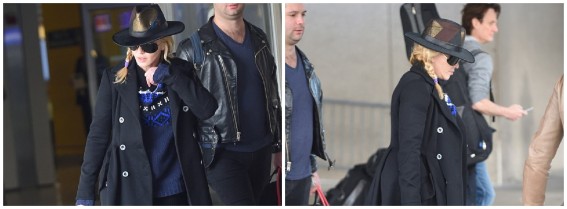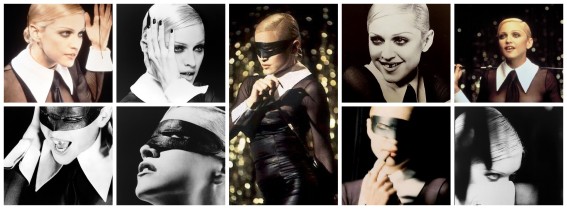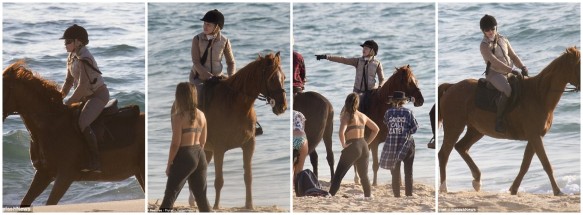YOU CAN FOLLOW US ON: FACEBOOK GOOGLE+ TWITTER INSTAGRAM TUMBLR PINTEREST SPOTIFY
Niki Haris discusses her years with Madonna
 Niki Haris was at Madonna’s side through the queen of pop’s many transformations from the mid-1980s through the dawn of the millennium. She was onstage for the “Who’s That Girl” tour, in the film “Truth or Dare” and in the iconic “Vogue” music video, singing and dancing with Madonna up through the “Ray of Light” era.
Niki Haris was at Madonna’s side through the queen of pop’s many transformations from the mid-1980s through the dawn of the millennium. She was onstage for the “Who’s That Girl” tour, in the film “Truth or Dare” and in the iconic “Vogue” music video, singing and dancing with Madonna up through the “Ray of Light” era.
She left to focus on motherhood and on a solo career that brings Haris to the JAS Cafe this week for her two-night, four-show Aspen debut with the James Horowitz Trio.
The lessons she learned at the top of the pop music world with Madonna were many.
“I learned discipline about creating your own vision and sticking to it,” Haris said in a recent phone interview. “And making sure that you’re living your own narrative, not judging yourself through somebody else’s eyes.”
The woman she knows and performed with, Haris said, is not the shrewd, trend-chasing Madonna we’ve heard about.
“People talk about how calculating she is, but I saw so many times when she would not do that and go with her gut,” Haris said.
Fourteen years since she stopped recording and performing with Madonna, Haris is still learning from her.
“I learned so much from her in the beginning,” Haris said. “Good stuff that now I go, ‘Oh, this is what she meant by that!‘”
Source: AspenTimes
Madonna Arriving At “JFK Airport”
Madonna to Visit “Live With Kelly And Ryan” Next 8 December
 Kelly Ripa and Ryan Seacrest will sit down for an exclusive interview with the “Queen of Pop” herself, MADONNA, on Friday, December 8, on LIVE WITH KELLY AND RYAN.
Kelly Ripa and Ryan Seacrest will sit down for an exclusive interview with the “Queen of Pop” herself, MADONNA, on Friday, December 8, on LIVE WITH KELLY AND RYAN.
The global superstar, who is recognized by Guinness World Records as the best-selling female recording artist of all time, will update the hosts about the latest in her life, career, philanthropy, artistry and most recent projects, including her MDNA Skin care line.
This marks Madonna’s sixth interview on “Live,” and her first visit to “Live with Kelly and Ryan.” Her last appearance took place on January 11, 2007.
Madonna In Porto For Bad Weather Conditions
Madonna by Liz Smith
“DO SOMETHING else! Do my eyebrows!”
That was our girl Madonna to one of her many helpers, in one of her many tender, lovely moments, via Alek Keshishian’s 1991 documentary, “Truth or Dare.”
 MADONNA was approaching the pinnacle of her career with the release of “Truth or Dare” which had followed her successful pairing with Warren Beatty in his candy-colored “Dick Tracy” and would coincide with her dazzling performance of Stephen Sondheim’s “Sooner or Later” from Beatty’s film — one of Madonna’s most assured live performances before her industry peers. She is famously, fearfully nervous at such events. (The song would win an Oscar.)
MADONNA was approaching the pinnacle of her career with the release of “Truth or Dare” which had followed her successful pairing with Warren Beatty in his candy-colored “Dick Tracy” and would coincide with her dazzling performance of Stephen Sondheim’s “Sooner or Later” from Beatty’s film — one of Madonna’s most assured live performances before her industry peers. She is famously, fearfully nervous at such events. (The song would win an Oscar.)
I recall being highly amused by the contradictory tone of the “Truth or Dare” reviews — was it a concert tour (fabulous color clips from “Blond Ambition”) … was it a cinema verite peek into the “real” Madonna (filmed in grainy black and white)? Or was it simply a narcissistic exercise by a practiced, unapologetic and relentlessly hard-working, disciplined provocateur? Answer, all three! How foolish to even have the argument. “Truth or Dare” remained the highest grossing documentary ever, for over decade. It is classic and relentlessly entertaining.
NO screen actress has enraged film critics as has Madonna from the day her second movie, “Shanghai Surprise” escaped. Her feature film work — 18 movies since 1985, ranging from cameos to carrying the load — has provoked almost unrelentingly negative, furiously offended notices. What began with such promise — her juicy second lead turn in “Desperately Seeking Susan” — reached its nadir with 2002’s “Swept Away” a movie consigned to the junk heap before a single frame had been shot. Connect the words Movie and Madonna and you might as well put up a sign: “Radioactive. Stay Away. This means YOU.”
Is it fair? Can she act? Well, yes, she can. No she can’t. She can. She can’t. My sister, my daughter! Perhaps only Martians could critique this woman’s efforts. The more you know of Madonna, the less plausible she is onscreen. She’s made some mind-bendingly poor choices, given frustratingly uneven performances — stiff one minute, convincing the next. She was even sabotaged by her own body while filming “Evita.” Her pregnancy became obvious, as did her concern, which inhibited her movements. Still and all, she’s not a cinema serial killer Really.
Where did it go wrong? What led her to box-office perdition? Part of the problem was that from the start, so much was expected of her. Watching those marvelous early music videos (so emotive, so photogenic) how could Madonna not become a major screen star? Everybody, including us, said so!
Like Elvis, Madonna achieved cultural icon status in an astonishingly short period of time. One minute just was just a voluptuous ratty-haired pop singer humping the stage at the MTV Awards. Within seconds her name had entered the American lexicon, as if she had always been there.
Elvis made a lot of movies. A lot of bad movies. But unlike Madonna, he didn’t look like he cared or was trying. At least not after his Army stint. Elvis became a puffy-faced somnambulist, doing it on auto pilot.
Madonna cares. Madonna tries. Madonna is not puffy. (She discovered the gym on her way to legendary status, which has not always been a beautifying obsession. The camera is not always kind to her sinew.) The problem is, we can tell she’s trying. We see the effort. She is not a timidly bad actress. (See Mariah Carey in “Glitter.”) She has a certain brazen confidence that drives reviewers crazy, There’s no sense of “I’m trying here, please be patient.” Nope, what you get from Madonna is, “Shhhh! Quiet! I’m acting!”
Madonna doesn’t beg. “I think I am a good actress” she has said several times. And, “I AM a movie star!” (The first remark is only occasionally true, the latter not at all. It is my belief she said she was a movie star to make the top of people’s heads explode. In the literal sense, it was true. She starred in movies.)
Relaxation is her problem. The more famous she became, the further she moved from the adorably brassy, loosey-goosey performance of “Desperately Seeking Susan.” I hate to encourage substance abuse, but I think Madonna should smoke a joint or have a few cocktails if she ever acts again.
HERE’s the rub. She freezes only when she is the star, the object of the audience’s undivided attention. Also, she is required to fulfill somebody else’s vision. Autonomous on the concert stage and usually right about her music, Madonna is likely too independent, too restless to conform to the tedium of filmmaking or the dictums of a director.
Go back and look at her oeuvre — and her movies, too. Richly tarty in “Desperately Seeking Susan,” “Bloodhounds of Broadway,” “A League of Their Own.” She’s a sizzling, double-entendre-spouting femme fatale in “Dick Tracy,” has a charmingly trashy few minutes in “Girl Six.” She is superb, emotionally naked as the insecure abused actress in Abel Ferrara’s messy “Dangerous Game.” (Her best work, really.)
Guy Oseary Pre-Wedding Moment
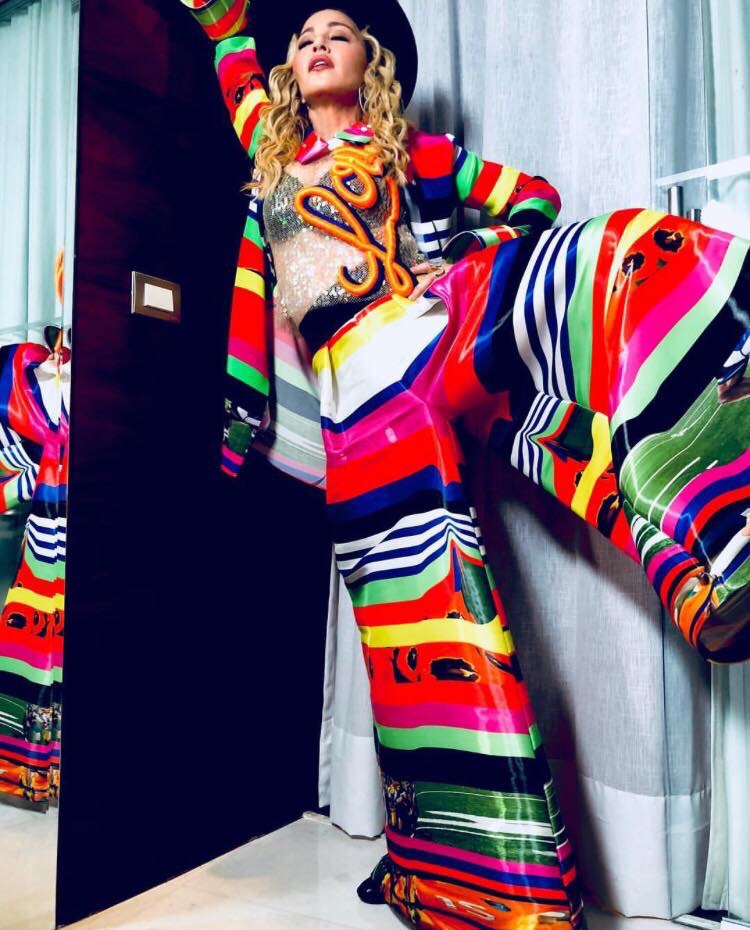
Holiday GHV2″ Thunderpuss DEMO Megamix Barry Harris – Listen + Download Link
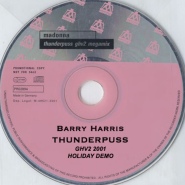
I don’t think anyone knows this was attempted.
Back in 2001 when Thunderpuss was asked to submit a GHV2 megamix for Madonna, an exec high up wanted to hear what it would sound like on top of “Holiday”, so while Jody Den Broeder started working on the regular megamix, i started on this.
I was pretty sure it couldn’t be done with the limited ‘pitch shifting’ technology at the time. So with the entire studio session of “Holiday” digitized now at my fingertips and about 10 different Accapellas i got to work. It was quite painstaking to work out the key to each song and to what note in Holiday (if looped) MIGHT make it work. So yes of course it was impossible to put 6-8 Madonna accapellas on top of one (Holiday), but i was certainly up for the challenge and kinda curious myself.
You’ll hear a few times it worked and a few times it didn’t. Nowadays i’m more confident it would work by using Melodyne. Bottom line, i spent days on this and yes there are a few times it sounds awful and a few accapellas totally out of key which i added in to prove the point that it couldn’t be done.
Nevertheless this was the best we could do with the request at the time, and yes Warner Bros agreed it was an idea that didn’t work, so it was scrapped.
click HERE for the audio
25 Years Ago – EROTICA
 Twenty-five years ago, Madonna changed. Sure, Madonna was always changing, but with the release of Erotica on Oct. 20, 1992, she fully shed her ebullient ’80s pop skin, donned a leather cat mask, and kicked open a rusty back alley door that previous chart-toppers only dared to scratch at.
Twenty-five years ago, Madonna changed. Sure, Madonna was always changing, but with the release of Erotica on Oct. 20, 1992, she fully shed her ebullient ’80s pop skin, donned a leather cat mask, and kicked open a rusty back alley door that previous chart-toppers only dared to scratch at.
You didn’t need to pick up a copy of her celebrity nude-filled coffee table book, Sex, to realize it. You didn’t even need to see Madonna Veronica Louise Ciccone, whip in hand, mugging for the camera in the video for the title track. All you needed to do was press play on the album and let the impossibly thick, libidinous bass line of “Erotica” start vibrating throughout your body. Forty seconds in, the sampled horns of Kool & the Gang’s “Jungle Boogie” flare up, but instead of sounding reassuring and familiar, they seem disembodied and eerie. Then, Madonna’s latest alter ego addresses you, low and firm: “My name is Dita / I’ll be your mistress tonight.”
If her earlier work was an invitation to celebrate sexuality without shame, Erotica was a challenge from Dita Parlo – Madonna’s unashamed, unflinching dominatrix persona – to witness and perhaps even indulge in society’s sexual taboos. Madonna may have addressed the male gaze before, but on Erotica, she wasn’t just staring back – she was making the world her sub.
Erotica occupies a watershed place in the pop pantheon, setting the blueprint for singers to get raw while eschewing exploitation for decades to come. For its 25th anniversary, Billboard spoke to the players involved in Madonna’s most creatively daring release. Here’s what producer-writer Andre Betts, backup singer Donna De Lory, producer-writer Shep Pettibone, co-writer Tony Shimkin and Living Colour bassist Doug Wimbish recall of the writing and recording of Erotica, the insane release party for the LP and book, and the collective societal pearl-clutching that followed.
Tony Shimkin: After doing The Immaculate Collection and “Rescue Me,” she let us know she was working on a new album and wanted us to be involved in the writing. Seeing I was a musician and writer and Shep [Pettibone] was more of a DJ and remixer, we collaborated on the writing of the tracks for the Erotica album. We went up to meet with her in Chicago, post-“Vogue,” when she was filming A League of Their Own. So we met with her and started to get to work on some music, and sent it to her as we were working our way through it. She would come into New York and have a book full of lyrics and melody ideas and we started working together in Shep’s home studio. I believe the first time she was in New York for an extended period, we were working on “Deeper and Deeper” and “Erotica” and “Bye Bye Baby.” She’s very driven. There’s was never a period of feeling it out — it was diving in headfirst.
Doug Wimbish: I remember Madonna when she used to go to the Roxy before she got really put on. I’d see her at the Roxy when Afrika Bambaataa was down there or [Grandmaster] Flash, and she was down there jamming out. And not just being a spectator, but being engaged in the scene. Madonna’s association with the dance music and the gay scene and the hip-hop scene merging in the downtown clubs in New York City, and her coming from Michigan, she got it…. And she knew Dre had something special. A song like “Where Life Begins” is right up his alley. She had a relationship with Dre for his rawness and realness. You gotta be around someone in this business who tells you, “No, I’m not digging that, that’s why.” And also keep the window open to listen. I think that’s what Dre did.
Andre Betts: “Where Life Begins” was the first song we wrote on Erotica. I started working on the track and she started writing lyrics. She called me a few weeks before and asked me over the phone, “I’ll be in New York in two weeks, do you want to work?” I’m like, “Yeah of course.” She’s like, “Find a studio, I don’t want to work in a popular studio, I want to be low-key.” [The studio I picked] was a hole in the wall for real. She came in, started writing, she’s like, “What do you think about this direction and these lyrics?” I was like, “That sounds like something I’d write.” Our session got interrupted because a big rat ran across the floor. I’m the only one that got the feet up so at first I didn’t think she saw it, and she goes, “Dre, stop being a bitch, it’s just a rat.” [Laughs] She said, “I’m from Detroit, I’m not worried about a rat.”
Shimkin: She really holds fast to a general rule, which is that she’s in charge of lyrics and melody, and you’re in charge of music. While she has her say in the music end, it’s more about the arrangement and how it works with her vocal. She’ll still be open to ideas you have about a vocal. One is her dominion, the other is yours, and they don’t meet that often, but it’s not unheard of to be able to comment either way.
Donna De Lory: She would completely just hear it in her head. Especially when we’re doing vocals. Sometimes [backup singer] Niki [Haris] and I would be like, “How ’bout this? How ’bout that?” And she was like, “Nope, this is how it’s going to be.” And it ended up being great. She was open to other ideas, but I really respected that.
Wimbish: [My first day in the studio], she rolls up and she’s got a box with these Playboy magazines from like the ’60s. She comes in, Dre sees her and she’s chilling, Dre’s like, “Yo what’s up Mo how you doing?” They start having a conversation. Dre says, “What do you got here in this box.” Before she can say anything Dre takes one of the magazines and opens to the center section, is like, “Damn these old babes had some titties back then!” Dre’s real straight up and down with her. She’s Madonna, she’s got that alpha female vibe — and no disrespect. I’m like “yo, let me see that.” She’s like, “No, no, I don’t want you to see anything ’til you play some bass.” Our relationship was broken in based on Dre, that moment and Playboy magazines. Dre’s looking at the centerfold, Madonna’s doing her Madonna thing, saying, “no, no,” and I’m like, “I’m not doing anything until I see some titties and ass.”
Shimkin: I was 21, 22 years old at the time. While I’d worked on a lot of major artists’ records and spoken to some of them, it can be intimidating at first. When we worked on “Vogue” I didn’t speak to her that much, but when we started working in [Shep’s] house [on Erotica] and you’re there every day, you realize somebody is just who they are. One time, she was asking me if I was done on the computer. She asked me a few minutes later and I was like “not yet,” and I started getting more nervous. The next time she asked me, I lost it and I thought it was the end of my career, I said, “I’m not done yet, make some fucking popcorn and I’ll let you know when I’m ready.” And she was like, “Ah-k.” I think she appreciated someone not being a sycophant and kissing her ass, and just being real. It became much easier as time went on. I think she enjoys having people around her who allow themselves to be themselves. She’s really no different than what she puts out there to the public in a movie like Truth or Dare. There’s not a persona and she doesn’t hide who she is.
Shep Pettibone: “Erotica” was four different songs throughout the process. She loved the groove. She would sing it one way, background vocals harmonies and all, then decide to erase everything and start over again. Every version was very good. Shame she made me erase stuff.
1992 : “Erotica” Photoshoot
Rolling Stone 1992 : Erotica Review
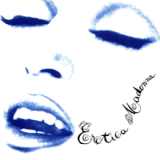 It took Madonna ten years, but she finally made the record everyone has accused her of making all along. Chilly, deliberate, relentlessly posturing. Erotica is a post-AIDS album about romance — it doesn’t so much evoke sex as provide a fetishistic abstraction of it. She may have intended to rattle America with hot talk about oral gratification and role switching, but sensuality is the last thing on the album’s mind. Moving claustrophobically within the schematic confines of dominance and submission, Erotica plays out its fantasies with astringent aloofness, unhumid and uninviting. The production choices suggest not a celebration of the physical but a critique of commercial representations of sex — whether Paul Verhoeven’s, Bruce Weber’s or Madonna’s — that by definition should not be mistaken for the real thing. It succeeds in a way the innocent post-punk diva of Madonna and the thoughtful songwriter of Like a Prayer could not have imagined. Its cold, remote sound systematically undoes every one of the singer’s intimate promises.
It took Madonna ten years, but she finally made the record everyone has accused her of making all along. Chilly, deliberate, relentlessly posturing. Erotica is a post-AIDS album about romance — it doesn’t so much evoke sex as provide a fetishistic abstraction of it. She may have intended to rattle America with hot talk about oral gratification and role switching, but sensuality is the last thing on the album’s mind. Moving claustrophobically within the schematic confines of dominance and submission, Erotica plays out its fantasies with astringent aloofness, unhumid and uninviting. The production choices suggest not a celebration of the physical but a critique of commercial representations of sex — whether Paul Verhoeven’s, Bruce Weber’s or Madonna’s — that by definition should not be mistaken for the real thing. It succeeds in a way the innocent post-punk diva of Madonna and the thoughtful songwriter of Like a Prayer could not have imagined. Its cold, remote sound systematically undoes every one of the singer’s intimate promises.
Clinical enough on its own terms when compared with the lushness and romanticism of Madonna’s past grooves, Erotica is stunningly reined in; even when it achieves disco greatness, it’s never heady. Madonna, along with coproducers Andre Betts and Shep Pettibone, tamps down every opportunity to let loose — moments ripe for a crescendo, a soaring instrumental break, a chance for the listener to dance along, are over the instant they are heard. Erotica is Madonna’s show (the music leaves no room for audience participation), and her production teases and then denies with the grim control of a dominatrix.
Against maraca beats and a shimmying horn riff, “Erotica” introduces Madonna as “Mistress Dita,” whose husky invocations of “do as I say” promise a smorgasbord of sexual experimentation, like the one portrayed in the video for “Justify My Love.” But the sensibility of “Erotica” is miles removed from the warm come-ons of “Justify,” which got its heat from privacy and romance — the singer’s exhortations to “tell me your dreams.” The Madonna of “Erotica” is in no way interested in your dreams; she’s after compliance, and not merely physical compliance either. The song demands the passivity of a listener, not a sexual partner. It’s insistently self-absorbed — “Vogue” with a dirty mouth, where all the real action’s on the dance floor.
Look (or listen) but don’t touch sexuality isn’t the only peep-show aspect of this album; Erotica strives for anonymity the way True Blue strove for intimacy. With the exception of the riveting “Bad Girl,” in which the singer teases out shades of ambiguity in the mind of a girl who’d rather mess herself up than end a relationship she’s too neurotic to handle, the characters remain faceless. It’s as if Madonna recognizes the discomfort we feel when sensing the human character of a woman whose function is purely sexual. A sex symbol herself, she coolly removes the threat of her own personality.
Pure disco moments like the whirligig “Deeper and Deeper” don’t need emotional resonance to make them race. But the record sustains its icy tone throughout the yearning ballads (“Rain,” “Waiting”) and confessional moods (“Secret Garden”). Relieved of Madonna’s celebrity baggage, they’re abstract nearly to the point of nonexistence — ideas of love songs posing as the real thing. Even when Madonna draws from her own life, she’s all reaction, no feeling: The snippy “Thief of Hearts” takes swipes at a man stealer but not out of love or loyalty toward the purloined boyfriend, who isn’t even mentioned.
By depersonalizing herself to a mocking extreme, the Madonna of Erotica is sexy in only the most objectified terms, just as the album is only in the most literal sense what it claims to be. Like erotica, Erotica is a tool rather than an experience. Its stridency at once refutes and justifies what her detractors have always said: Every persona is a fake, the self-actualized amazon of “Express Yourself” no less than the breathless baby doll of “Material Girl.” Erotica continually subverts this posing to expose its function as pop playacting. The narrator of “Bye Bye Baby” ostensibly dumps the creep who’s been mistreating her, but Madonna’s infantile vocal and flat delivery are anything but assertive — she could be a drag queen toying with a pop hit of the past. Erotica is everything Madonna has been denounced for being — meticulous, calculated, domineering and artificial. It accepts those charges and answers with a brilliant record to prove them.
“Erotica” & “Sex” : Why Musical Masterpiece, Defiant Book Still Matter
 How the icon’s 1992 projects (her own ‘Lemonade’) tackled homophobia, AIDS hysteria and female, queer desire, and set the blueprint for modern pop.
How the icon’s 1992 projects (her own ‘Lemonade’) tackled homophobia, AIDS hysteria and female, queer desire, and set the blueprint for modern pop.
In 1990, Madonna was as astronomically popular as a boundary-bulldozing, unapologetically bacchanalian performance artist could get. Drawing from Harlem drag balls, “Vogue” went Number One nearly worldwide. The tour showcasing it, Blond Ambition, mixed spectacle with social commentary so sharply that it reinvented the pop concert and yielded the smash documentary Truth or Dare. And that year’s The Immaculate Collection, her first greatest-hits set, would eventually rank among the world’s biggest-ever albums, despite MTV banning its gender-blurring and cinematically exquisite “Justify My Love” video.
Some loathed this classically trained dancer/DIY provocateur – a megastar peer of Prince and Michael Jackson since her 1984 blockbuster Like a Virgin – with a venom reserved for successful women forging their own path. But for her vast audience, she was nothing less than liberating, and her uninterrupted string of hits defined pop for a decade. What some considered violations of taste made her more commanding: Even the way she toyed with ordinarily unflappable talk show hosts like David Letterman was more rock & roll than actual rock stars.
Nearly everything changed two years later with Erotica and Sex. Released respectively on October 20th and 21st, 1992, the first fruits of her multimedia Maverick entertainment company weren’t flops; her fifth studio album, Erotica racked up six million sales worldwide and yielded several hits, while Sex – an elaborate coffee table book created with fashion photographer Steven Meisel and Fabien Baron of Harper’s Bazaar – sold out its limited 1.5 million printing in a few days, an unparalleled success for a $50 photography folio bound in metal and sealed in a Mylar bag to evoke condoms. It remains one of the most in-demand out-of-print publications of all time.
But both record and book, despite a few positive reviews, inspired widespread vitriol. “There’s nothing erotic about it, unless one finds the idea of a singing death mask sexy.” That was Entertainment Weekly’s take on Erotica’s rendition of “Fever,” but it summed up many assessments of the entire album. Others appreciated Sex’s forthright presentation of LGBTQ sexuality and S&M even less. “Of course, some of us actually like the opposite sex; some of us believe it is possible to have great sex without whips, third parties or domestic pets,” groused not some reactionary macho windbag, but a female film critic for The New York Times.
Why did projects Madonna intended to open minds shut so many down?
As her stardom snowballed through the Eighties and early Nineties, AIDS decimated the scene that helped birth Madonna. Taking music and fashion cues from lower Manhattan’s punk rebelliousness and midtown’s disco hedonism, pre-stardom Madonna was a fixture in the bohemian underground chronicled by photographer Nan Goldin in her autobiographical The Ballad of Sexual Dependency, a likely Sex influence, along with the severe stylization of Helmut Newton, Guy Bourdin and Robert Mapplethorpe. By 1992, AIDS claimed Goldin’s subjects, Mapplethorpe himself, much of the art world (including Madonna’s friend Keith Haring), and a growing chunk of Madonna’s audience. It also killed and would go on to kill her cohorts, including Blond Ambition dancer Gabriel Trupin. Just as racism and the Black Lives Matter movement shaped Beyoncé’s Lemonade, AIDS and ACT UP – the AIDS Coalition to Unleash Power, the direct action advocacy and educational group whose motto was “Silence = Death” – yielded Erotica and Sex.
Madonna previewed both works with the lead single and video for “Erotica,” which boldly picked up where “Justify My Love” left off, and is narrated by Mistress Dita, her Sex dominatrix alter ego. “Give it up, do as I say,” she growls over gritty funk that combines the clatter of R&B’s New Jack Swing with house music’s heavy bottom. “Give it up and let me have my way.”
But in much of what follows on the LP, the woman behind the vixen doesn’t get what she wants: Her relationships fall apart as she awakens from spells cast by deceptive lovers (“Bye Bye Baby,” “Waiting,” “Words”). Booze, chain–smoking, and anonymous sex can’t numb the pain (“Bad Girl”), and a friend steals her man (“Thief of Hearts”). Meanwhile, comrades die (“In This Life”) while kindred outcasts struggle (“Why’s It So Hard”). “I’m not happy this way,” she sings in “Bad Girl.” Sensuality was merely part of the picture: Erotica is Madonna’s concept album about love and intimacy under the shadow of plague.
In excerpts from his studio diary, Erotica’s co-producer/songwriter Shep Pettibone – a skilled remixer who helped Eighties dance grooves evolve from disco to house music – archived the singer’s feedback on the album’s early slick mixes. “I hate them,” she said. “If I had wanted the album to sound like that, I’d have worked with [earlier collaborator] Patrick Leonard in L.A.” Instead, Madonna demanded rawness, “as if it were recorded in an alley at 123rd Street in Harlem.”
Continue reading ““Erotica” & “Sex” : Why Musical Masterpiece, Defiant Book Still Matter”
Madonna Before She Was Madonna
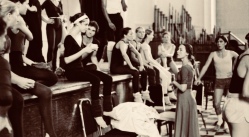 Seven years later, after 1984’s “Like a Virgin” and 1985’s “Desperately Seeking Susan” established Madonna as a huge star and the it-girl of that moment, Maschal wrote a followup column about his earlier impressions of her. He noted her beauty, aura and precocious self-assurance – and also that she resembled a literal Renaissance madonna.
Seven years later, after 1984’s “Like a Virgin” and 1985’s “Desperately Seeking Susan” established Madonna as a huge star and the it-girl of that moment, Maschal wrote a followup column about his earlier impressions of her. He noted her beauty, aura and precocious self-assurance – and also that she resembled a literal Renaissance madonna.
“I really did think she looked like a madonna and so was amazed when I asked her name and she gave it,” Maschal said recently via email. “I also found her one of the most self-absorbed persons I had ever met.”
That self-absorption also manifested as confidence, which would stand Madonna in good stead as she pursued her career. One of her 1978 ADF classmates was Eric Tyrone Smith, who later shared a West Village apartment with Madonna in New York City. In a 2007 email, he recounted a salient memory of Madonna’s evolution from dancer to singer.

